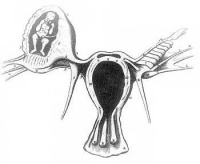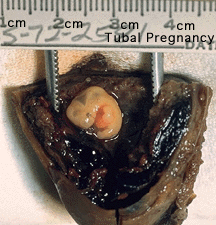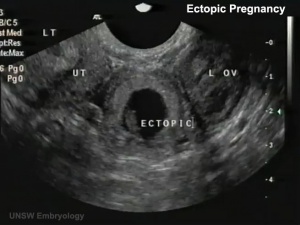Abnormal Development - Ectopic Implantation
Introduction
Human development during week 2 is about implantation and the endocrine signaling to block the normal menstrual cycle. The blastocyst implantation process should normally and does occur within the body of the uterus. There are a number of additional abnormal sites of implantation that are outside the uterine body, these are described as ectopic implantation or ectopic pregnancy. The most common form of human ectopic pregnancy is when implantation occurs within the uterine tube, described as a tubal pregnancy. Note that the endocrine signals blocking the menstrual cycle and indicating a pregnancy will still be released following this ectopic implantation. Ectopic pregnancies are therefore often identified by early ultrasound scans.
Ectopic pregnancy is also a high-risk maternal medical condition with an approximate incidence of 1.5 to 2 % in reported pregnancies. This is also the most common cause of pregnancy-related deaths in the first trimester. The risk factors for tubal ectopic pregnancy include: tubal damage by infection (particularly Chlamydia trachomatis) or surgery, smoking and in vitro fertilization therapy. Tubal damage is often described as "scarring" and can affect the cilia-mediated transport of the blastocyst during the first week of development.
Some Recent Findings
- Human tubal ectopic pregnancy and knockout mouse models.[1]"Tubal abnormalities and dysfunction, such as altered contractility or abnormal ciliary activity, have been speculated to lead to tubal ectopic pregnancy. To elucidate the cellular and molecular mechanisms of the tubal transport process, several knockout (KO) mouse models have been developed. This review summarizes what has been learned from studies of the Fallopian tube in caspase-1, cannabinoid receptor and Dicer1 KO mice."
Ultrasound Ectopic Implantation
Tubal Ectopic Pregnancy
Cervical Ectopic Pregnancy
This form of ectopic pregnancy is a rare high-risk condition and represents less than 1% of all ectopic pregnancies. The reported incidence varies between 1:1,000 to 1:18,000.
References
- ↑ <pubmed>20023297</pubmed>
Reviews
- Ectopic pregnancy in animals and humans. Corpa JM. Reproduction. 2006 Apr;131(4):631-40. Review. PMID: 16595714
- Current knowledge of the aetiology of human tubal ectopic pregnancy. Shaw JL, Dey SK, Critchley HO, Horne AW. Hum Reprod Update. 2010 Jan 18. [Epub ahead of print] PMID: 20071358
Articles
Search Pubmed
June 2010
- "ectopic pregnancy" All (14958) Review (1350) Free Full Text (1196)
- "tubal pregnancy" All (8010) Review (683) Free Full Text (630)
Search Pubmed: ectopic pregnancy | ectopic implantation | tubal pregnancy | tubal implantation
Glossary Links
- Glossary: A | B | C | D | E | F | G | H | I | J | K | L | M | N | O | P | Q | R | S | T | U | V | W | X | Y | Z | Numbers | Symbols | Term Link
Cite this page: Hill, M.A. (2024, April 30) Embryology Abnormal Development - Ectopic Implantation. Retrieved from https://embryology.med.unsw.edu.au/embryology/index.php/Abnormal_Development_-_Ectopic_Implantation
- © Dr Mark Hill 2024, UNSW Embryology ISBN: 978 0 7334 2609 4 - UNSW CRICOS Provider Code No. 00098G


